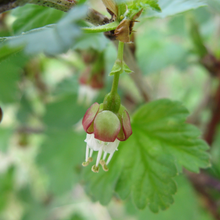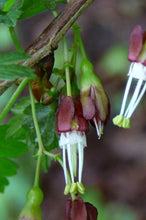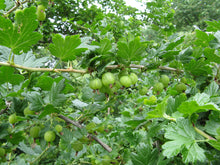Ribes divaricatum
Wild black gooseberry, also known as spreading or wild coast gooseberry, is a large deciduous shrub that is a habitat powerhouse! Hummingbirds, butterflies, bees and other insect pollinators flock to its diminutive but unique white flowers each spring, while birds adore its graceful arching branches for nesting and refuge and its shiny, purplish-black berries for food. Do note, it is armed with thick thorns, especially at the leaf nodes, which is one of the reasons it provides such exceptional cover for wildlife and makes a perfect addition to barrier plantings and habitat hedgerows.
- Plant type/canopy layer: deciduous, perennial, large shrub
- Size at maturity: 5’-12' tall, 6-10' wide
- Light requirements: full sun to part-shade
- Moisture requirements: moist soil
- Bloom time: March - June
- Growth rate/ease: moderate growth rate, easy to grow
- Wildlife support: flowers attract and provide nectar to hummingbirds, adult butterflies, bees and other insect pollinators; fruits attract and provide food for backyard birds; thorny branches provide exceptional nesting and refuge habitat for birds; overall plant attracts and supports beneficial and pest eating insects and is believed to be a caterpillar host plant and larval food source for up to 85 species of native butterflies and moths including Milbert's Tortoiseshell, Satyr Comma, and Tailed Copper
- Native habitat/range: locally common in moist forest edges, from the bluffs of the Pacific coastline westward to open alpine forests of the Cascades, from British Columbia all the way down to California, hugging the coastline more closely in the southern reaches. Portland Plant List - yes.
- Special features & uses: hummingbird, pollinator and bird magnet; deer resistant; edible fruits, traditionally eaten by a number of indigenous American groups; medicinal, especially the bark; landscape uses include erosion control, pollinator gardens, hedgerows and screens
Gardening with Wild Black Gooseberry: Select this shrub (or several of them) if you’re designing a habitat hedgerow or generally looking for tremendous bang for your buck in terms of creating wildlife habitat. It will thrive in full sun, part shade, and dappled light areas with moist, well-drained, loamy soils. Generally the more sun it receives, the more moisture it will require. It also tolerates seasonal flooding and controls erosion, making it an excellent choice raingardens or bioswales. Deep, infrequent summer water may be required (i.e. 2-3 times per month) during the summer drought.
Photo Credit 1: "File:Black velvet gooseberry 1.jpg" by Nadiatalent is licensed under CC BY-SA 3.0
Photo Credit 2: "File:Ribes divaricatum fruit2.jpg" by Nadiatalent is licensed under CC BY-SA 3.0
Photo Credit 3: "Ribes divaricatum" is licensed under CC BY-SA 4.0






